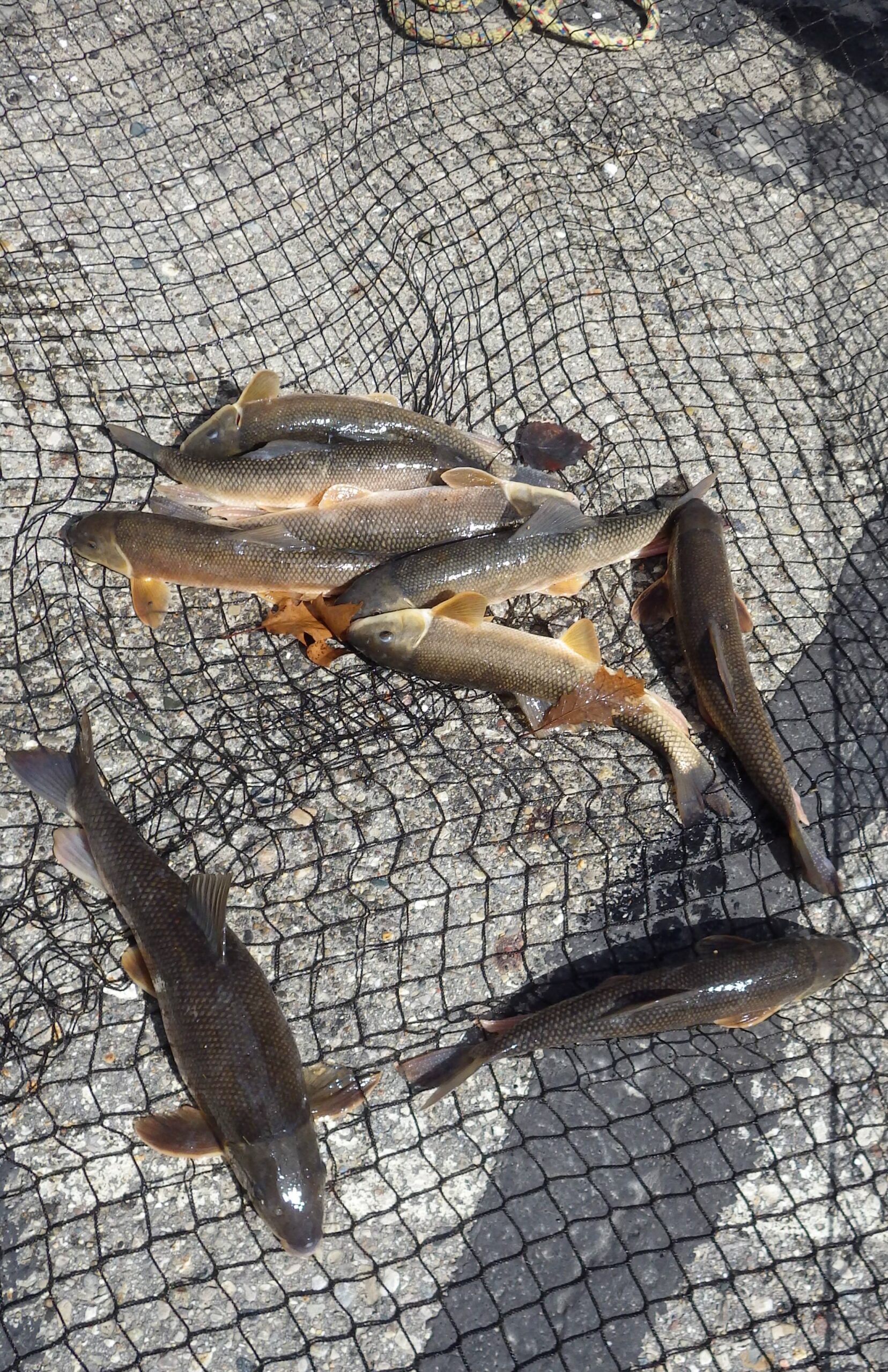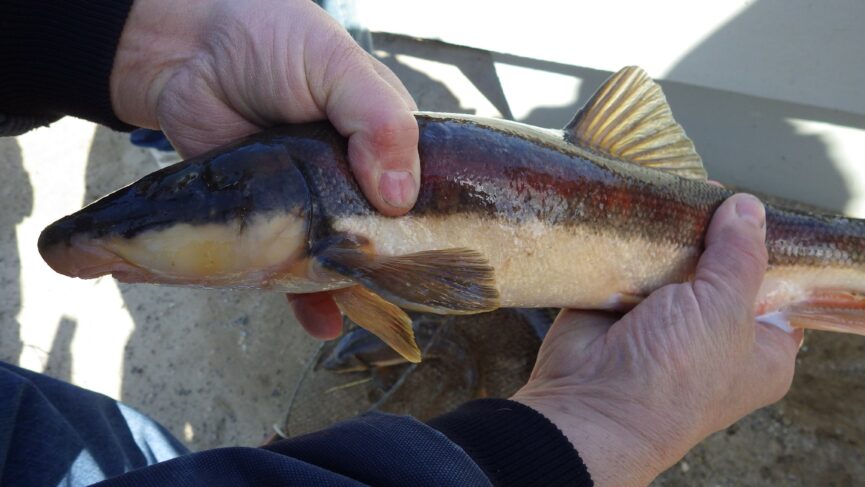
By: Tom Lounsbury.
Spring sucker fishing is a very popular outdoor pastime in Michigan, which includes various techniques such as with hook and line, spearing (including bowfishing with archery tackle) and netting. In my agricultural Thumb area featuring countless drainages, I grew up with “sucker-spearing”, and it is a time- steeped pastime I much enjoy, and freshly cooked sucker is seasonal flavor I yearn for. For years, sucker-spearing had established seasons, typically set in April with various opening days occurring on different dates according to different zones in Michigan, which I had a problem with, because in my locality, it often didn’t occur until mid-April. There were several times when I ventured out on the opener, the peak sucker run had already taken place, making for slim pickings. Not that many years ago, sucker spearing became open all year, which I look upon as a good thing. Suckers don’t look at any calendars, and everything depends upon the spring runoff with regards to water temperature. A warm (somewhat anyway according to springtime) rain will cause the suckers a day or two later to venture in from the lake and up the various drainages in order to spawn. While I had heard about netting suckers with large dip nets, I had never partaken of this activity until I received an invitation over 20 years ago from my good friend, the late Tom Talaski Sr, whose family farm is located close to the small burg of Rapson, near the tip of the Thumb and in the middle of rivers, streams and drainages. Tom’s 12 children (7 boys and 5 girls) grew up in the spring sucker spearing atmosphere, and as the children grew up and started families of their own, he decided to create a pastime involving the entire family, and friends as well, in a celebratory and holiday atmosphere involving spring sucker fishing. He realized that his farm-orientated large family was well into working cohesively together, and dip netting for suckers, which requires teamwork, became an obvious priority. This required research by Tom and his sons on how to create a 9 feet by 9 feet (the legal maximum size) dip net, and where to locate the materials for constructing such, because at the time, none were available on the market. They located a source for the netting, but it was a trial-and-error effort figuring out the metal crosspieces. The first attempt was using the curved bars (aka teeth) off an antique hay dump-rake, but such proved to be too rigid, and offered no flexibility. It was eventually discovered that spring steel sewer rods were a perfect choice which offered the necessary strength and flexibility that allowed the net to form the perfect pouch to hold many suckers when lifting them up out of the water. I have witnessed when so many suckers were in a Talaski dip net, that small, long- handled dip nets had to be used to scoop out individual suckers in order to lighten the load to be able to pull the remainder up with helping hands on the rope. Yep, folks, it can be quite a load if all goes well. Large dip nets of this nature remind me of the same concept as the much smaller “umbrella drop nets” which are used to catch minnows and crayfish to be used as bait. The Talaski family clan uses two nets a bit apart (and sometimes on opposite sides of a bridge) which are dropped off in unison from the many bridges located on their seasonal route. The large nets are attached to long and stout ropes, and on command, the nets are quickly raised up out of the water in the hopes they contain suckers. It is a moment of anticipation and all who are present are attentively watching to see what the nets may contain. Sometimes they are empty, sometimes have only a sucker or two, and sometimes it can be extremely exciting for all, with a motherload of fish. After two decades of joining this family for their springtime sucker fishing celebrations, I have witnessed the little kids present growing up and becoming parents themselves, and in turn, bringing their kids. Involving children during this annual gathering has always been a priority, and it is typically held on a Saturday when kids can attend and enjoy all the fun without missing school. One thing I discovered right away is that you never go hungry during this special family gathering. At each bridge stop, the food comes out for all to enjoy. Cookies, cheese, crackers, hot soup and cocoa, with a special delight being smoked jerky, hunter sausage and fish from the Talaski smokehouse. The smokehouse itself is a time-steeped Talaski family tradition which was started by Tom Talaski Sr and is now proudly managed by his son Pat who now resides at the family homestead just north of Rapson. When I first joined the Talaski family “sucker festival”, the start date for dip netting suckers was always on April first. And like the other scheduled sucker openers, it wasn’t always prime time, depending upon the fickle spring weather. However, this good natured family sure did enjoy “April Fools’ Day” with the usual pranks taking place. During this time, no matter what day of the week the date fell on, the nets were ready to go, and unfortunately kids wishing to attend during a weekday had to play hooky. The dip netting (aka hand netting) season now runs from March 1 to May 31, which allows easier scheduling to involve children. This year the Talaski family, including some from other parts of the state, would get together last Saturday on April Fool’s Day, and of course the good- natured pranks would once again come into play. After a nighttime thunderstorm, the morning would dawn with a bright April sun and clear blue skies, and in no time, our long caravan of vehicles were headed out. At the first bridge stop, it was readily apparent that the rain during the night combined with the typical runoff had caused the river to overflow its banks, with the water level reaching all the way up to the bottom of the bridge. Still, the attempt was made to net suckers in the deep and murky water, but to no avail. Pulling the nets back in against a strong current turned into a genuine tug-of-war contest requiring extra hands, which are always ready with this crew. A very unique thing happened at the second bridge while we were waiting to pull the nets up for a look-see. A hawk with a duck in its talons flew past just above our heads, and then lost its grip on the duck, which plopped into the water and disappeared. The hawk hovered for a couple seconds above where the duck had dropped in, and then flew away. The male wood duck, briefly popped back up, looked around, and dove out of sight, never to be seen again. I’m certain he swam to safety from “eyes in the sky” by going under the bridge. It was while the hawk was very briefly hovering about 20 feet away in front of us, I determined by its barred markings on its back, wings and tail, and medium stature that it might be a Cooper’s hawk, but on second thought, it could have also been a similar sized peregrine falcon, which is also known to be called a “duck hawk” for targeting its favorite prey. Be that as it may, it was an exciting moment in nature shared by all present. We would stop and try netting suckers at several “tip of the Thumb bridges”, with all featuring murky and turbulent waters, and no suckers. Except for the very last bridge, when a very large female white sucker, her belly heavily swollen with eggs, was netted. This was an exciting moment for the kids, who all took time to admire the beautiful fish. This was also a good sign that the peak run was, well, maybe, about to begin sometime soon, pending the ongoing fickle weather of course. Female suckers are typically the first to venture in from the big lake, and soon joined in by the males. The most common sucker venturing into the Thumb is the white sucker. However in the tip of the Thumb, a very beautiful sucker can be found, especially in rivers and streams with rocky bottoms. The Talaski clan always refers to these suckers as being “red sides”, and their technical name is long-nosed sucker, and it is also commonly referred to as a sturgeon sucker, due to its longer snout. It has smaller scales than other sucker species, beautiful bright red sides and loves cold northern waters, and can even be found in Russia where it is known as the Siberian sucker. I was with the Talaski family a couple springs ago, and most suckers netted were gorgeous “red sides”. One thing is for certain, I’m already looking forward to the next Talaski family sucker festival, and I feel very honored and appreciative that they have adopted me!

